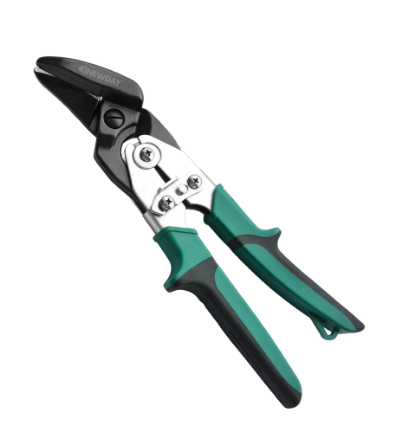Types of Aviation Snips and Their Applications
Straight-Cut Aviation Snips: Ideal Uses
Straight cut aviation snips stand out as must-have equipment when it comes to getting clean cuts across different materials like sheet metal, plastics, even thick leather stuff. Contractors working on things like roof installations or wall paneling really appreciate them because nothing beats having those perfectly straight edges. The design with its extended blade gives workers better grip and control, so cuts come out neater without wearing out the hands too fast after hours of work. Most plumbers and HVAC technicians I've spoken to swear by these particular snips since they handle all sorts of jobs where straight lines matter most. Just ask anyone who's spent time trying to patch ductwork or install ventilation systems what happens when straight cut snips aren't available during a job site emergency.
Left-Cut vs. Right-Cut: Navigating Curves and Corners
When working on projects that need curved cuts or involve navigating tight corners, left cut and right cut aviation snips really shine. The way these tools are designed lets them cut in opposite directions, so craftsmen can create smooth curves and sharp corners without much hassle. Most metalworkers keep both types handy at their workstation because having access to both directions makes all the difference when tackling complex shapes. Anyone who has spent time in a fabrication shop knows that getting the right snip for the job cuts down on mistakes and saves time reworking bad cuts, ultimately leading to better finished products with cleaner edges throughout.
Specialty Aviation Snips for Unique Tasks
When regular aviation snips just won't cut it for certain jobs, specialty snips step in with their customized approach. They handle those tricky situations where someone needs to shear metal, craft detailed patterns, or work with tough stuff like fiberglass that regular tools struggle with. What makes these special? Usually they come with blades shaped differently from standard ones or have adjustable parts that let workers fine tune how they cut based on what material they're dealing with. Take notching snips for instance – plumbers and HVAC technicians swear by them when they need to make those tiny cuts without damaging surrounding areas. Most pros keep a few different specialty snips handy because they really do make life easier when faced with complicated cutting tasks that would take forever with basic tools.
Key Features to Evaluate in Aviation Snips
Blade Material and Durability
What kind of blade aviation snips have really matters for how well they work and how long they last. Most good quality snips use high carbon steel blades since they're strong enough to handle tough jobs like cutting through stainless steel without getting damaged easily. Anyone working regularly with these tools should look at blades that come with some sort of protective treatment or coating against rust, especially important for folks who work in damp workshops or outdoor settings where moisture is always around. Industry experience shows that picking the right blade material can double the life of those expensive snips, so taking time to check this detail before buying makes sense both practically and economically in the long run.
Ergonomic Handle Design for Comfort
Good ergonomic handles on aviation snips really cut down on wrist strain when someone needs to work with these tools for hours at a time. How the handle fits the hand makes all the difference when it comes to getting precise cuts without tiring out too quickly. Most newer models now come with soft rubber grips and adjustable parts so people with different sized hands can still get a good hold. Studies from tool manufacturers indicate that workers who switch to ergonomically designed snips report about 30% less hand fatigue after long days on the job. For plumbers, electricians, and other tradespeople dealing with tough materials day in and day out, investing in proper tool ergonomics isn't just comfortable it's practically necessary for staying productive over time.
Cutting Capacity and Gauge Thickness Limits
Knowing what aviation snips can actually cut makes all the difference when working on metal projects. The cutting capacity basically tells us how thick a material these tools handle before they start struggling. Most aviation snips come with ratings for different gauges of steel typically between 18 and 24 gauge. Workers need to check those specs carefully because going beyond what the tool is designed for often leads to bent blades or worse. We've seen plenty of shops waste money replacing damaged snips simply because someone tried cutting something too thick. A good rule of thumb is always cross reference manufacturer info before starting any job. When folks understand their tools limitations, they not only save cash in the long run but also get better results from their work.
How to Match Aviation Snips to Your Specific Projects
Assessing Material Type and Thickness
Matching aviation snips to a job starts with knowing what kind of material needs cutting and how thick it is. Materials vary widely from metals to plastics and even composite stuff, each needing different types of snips to get good results. Take metal sheets for example they often need heavier duty snips compared to something soft like plastic. Thickness matters too. Getting the right snips means they can handle the material without breaking down or just not working properly. Most manufacturers actually provide cutting charts that show which snips work best with specific materials. These charts save headaches later on because nobody wants to deal with bad cuts that waste both time and money in the long run.
Considering Cut Complexity (Straight vs. Curved)
The kind of cuts needed for any given job really matters when picking out aviation snips. If someone needs to make simple straight lines versus complicated curved shapes, they should definitely grab the right cutting tool for what they're working on. Straight cut snips work great for those long flat pieces where accuracy counts. Left and right cut versions come into play when dealing with angles and tricky curves, giving much better control over things like custom metal fabrication projects. Most experienced workers keep both kinds handy because different jobs call for different tools. Trying to force one type of snip through all sorts of cuts just isn't going to work well. People end up with messy results that take extra time to fix later on.
Frequency of Use: Professional vs. DIY Needs
How often someone needs to cut things makes all the difference when picking between light tools for weekend warriors and serious snips for pros who cut daily. Pros definitely need those heavier aviation snips since regular cutting wears down cheaper tools pretty fast. Hobbyists working on occasional home projects usually go for something lighter and cheaper, but honestly these budget picks just don't last as long before breaking down. Studies show people who spend extra bucks upfront on good quality snips end up happier in the long run, particularly if they plan to use their tools frequently. Getting the right tool for usage frequency actually saves money overall because it means fewer replacements down the road, even if the initial cost seems steep.
Maintenance Best Practices for Optimal Performance
Proper Cleaning and Lubrication Techniques
Keeping aviation snips in good working condition means they last longer and work better when needed most. The first thing anyone should do is clean those blades regularly. This helps them cut through materials without getting bogged down by built-up grime and dirt. When blades get dirty, cuts just aren't as precise anymore, which makes everything take longer. Most people forget about lubrication until problems start showing up. But applying oil to the moving parts after heavy use keeps things running smoothly and stops rust from forming over time. A basic cleaning schedule does wonders for both accuracy and protection against corrosion, which naturally makes tools last much longer than expected. Some field reports indicate that well maintained tools perform around 30% better overall, which explains why many professionals make maintenance part of their daily routine instead of an afterthought.
Storage Solutions to Prevent Damage
Storage matters just as much as regular maintenance when looking after aviation snips. When kept properly, these cutting tools avoid getting damaged and remain sharp enough for whatever job comes next. Most folks find that putting their snips into protective covers or hanging them on magnetic strips works wonders for keeping blades sharp and preventing anyone from grabbing them without thinking. A good organizational system makes all the difference too. Nobody wants to spend time hunting around for misplaced tools or forget to clean them regularly. Some workshops report that investing in decent storage racks actually doubles how long their hand tools last before needing replacement. Beyond simply having everything within reach, proper storage habits really do enhance cutting performance over time, which means fewer replacements down the road.
FAQ
What are aviation snips primarily used for?
Aviation snips are primarily used for precise cutting of materials such as sheet metal, plastic, and leather. They are essential tools for tasks requiring straight, curved, or intricate cuts.
How do I choose the right aviation snips for my project?
Choosing the right aviation snips involves evaluating the material type and thickness, understanding the complexity of the cuts required (straight vs. curved), and considering the frequency of use (professional vs. DIY).
Why is blade material important when selecting aviation snips?
Blade material is crucial as it determines the durability and performance of aviation snips. High-carbon steel is often preferred for its strength, which is necessary for cutting tougher materials. Treating blades to prevent corrosion also extends their lifespan.
What maintenance is required for aviation snips?
Regular cleaning and lubrication are essential to maintain aviation snips. Proper storage also prevents damage, ensuring the tools remain effective and ready for future use.


